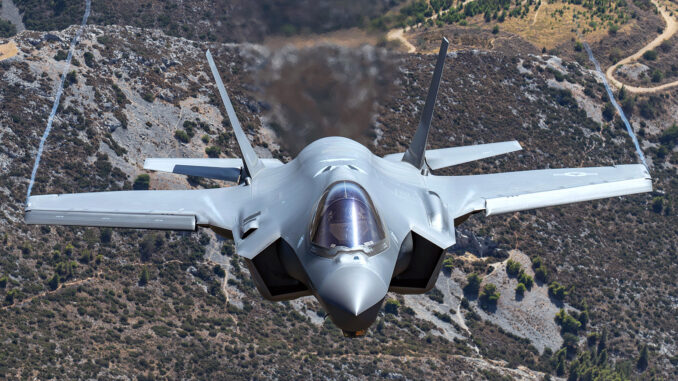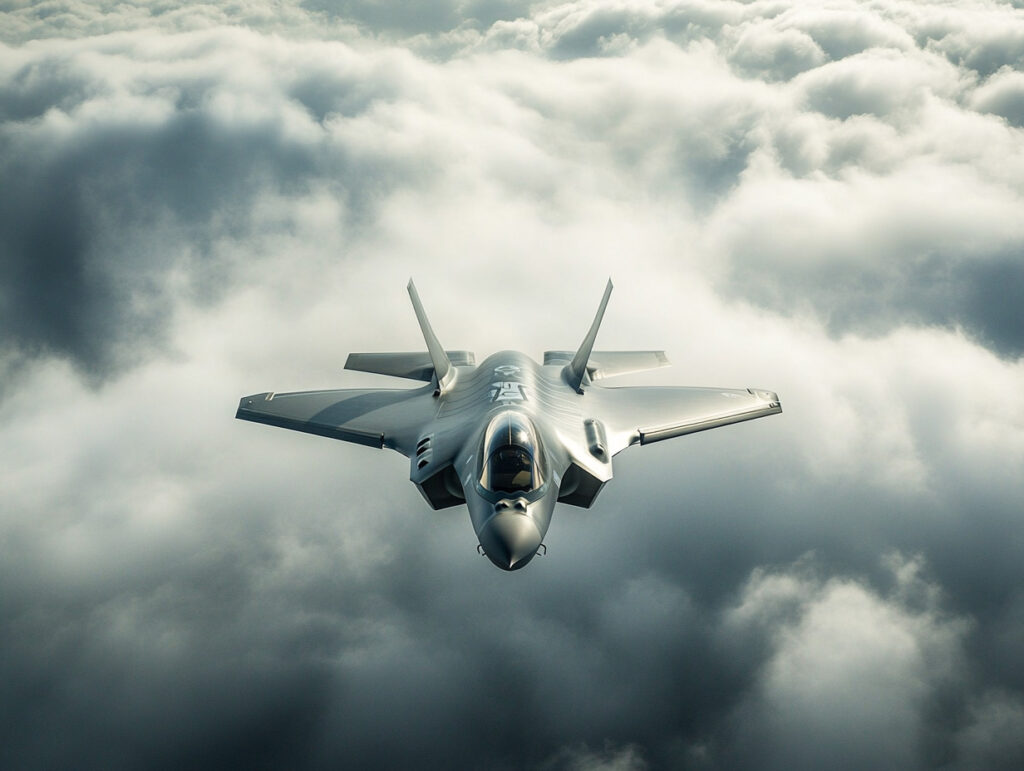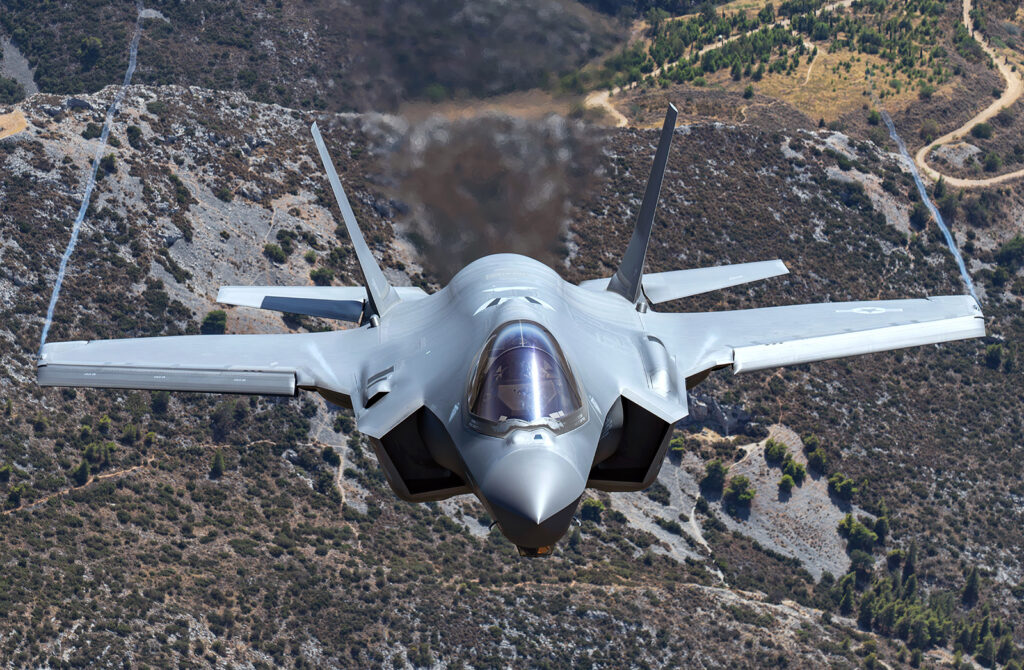
Analysis of F-35 classified data sharing with NATO members to improve integration with fourth generation fighters.
NATO member countries are benefiting from increased access to sensitive information about the F-35 stealth fighter, enabling them to better exploit the aircraft’s capabilities in the context of interoperability with fourth-generation fighters. This data sharing, which includes Special Access Programmes (SAPs), aims to enhance the cooperation and effectiveness of NATO air forces. This article explores the technical and strategic implications of this initiative, including the integration of electronic warfare systems, improved communication between different generations of aircraft, and the challenges associated with securing this crucial information.

The importance of sharing sensitive information about the F-35 within NATO
The F-35 Joint Strike Fighter, with its stealth capabilities and advanced technological architecture, is a major asset for NATO air forces. However, its optimum integration into existing fleets requires in-depth information sharing between member countries. Sensitive information on the F-35, covered by Special Access Programmes (SAP), enables NATO members to better understand and exploit the unique capabilities of this aircraft in various combat scenarios.
Data sharing includes information on the aircraft’s sensors, electronic warfare systems and data fusion capabilities. These elements are essential to maximise the effectiveness of the F-35 as a multi-role platform, capable of carrying out air superiority, reconnaissance and precision strike missions. For example, the F-35’s AN/APG-81 radar, which uses Active Electronically Scanned Array (AESA) technology, enables highly accurate detection and tracking of targets, even in complex electronic warfare environments.
Sharing this information also enables NATO countries to improve their interoperability, particularly when it comes to coordinating operations between fourth- and fifth-generation aircraft. This cooperation is crucial to maintaining collective air superiority in the face of potential threats, particularly in the context of the war in Ukraine and increased tensions with Russia.
Integrating the F-35 with fourth-generation fighters
One of the main challenges posed by the introduction of the F-35 into NATO fleets is its integration with fourth-generation fighters, such as the F-16 and the Eurofighter Typhoon. The F-35 uses communications and data-sharing systems that are not immediately compatible with those of older aircraft, which complicates joint operations.
A crucial aspect of this integration is the F-35’s Multifunction Advanced Data Link (MADL) system. This system offers secure communication with a low probability of interception or detection, which is essential for stealth missions. However, fourth-generation fighters mainly use Link 16, which, although widely used, presents an increased risk of detection by enemy forces.
To overcome these challenges, innovative solutions are being developed, such as Lockheed Martin’s Sniper Networked Targeting Pod. This pod, mounted on fourth-generation fighters, enables critical data from the F-35 to be received and transmitted using MADL, while maintaining the safety and efficiency of operations. This technology enables older fighters to benefit from the information gathered by the F-35, reinforcing operational cohesion between the different generations of aircraft.
The successful integration of the F-35 with fourth-generation fighters is essential to maximise NATO’s collective air power. It enables the F-35’s stealth capabilities to be exploited to the full, while taking advantage of the strengths of older aircraft, such as their combat-proven manoeuvrability and versatility.
Challenges in securing F-35 information
Sharing sensitive data between NATO member countries, while essential for collective effectiveness, presents security challenges. Special Access Programmes (SAPs) are designed to protect the most sensitive information about the F-35’s capabilities, such as its advanced sensor systems, electronic countermeasures and communications protocols. However, the dissemination of this information across multiple nations requires robust security protocols to prevent leaks and compromise.
The United States has long been reluctant to share information covered by EWS, because of the potential risks to national security. However, in the current context of heightened geopolitical tensions, particularly in Eastern Europe, this approach has evolved to allow greater collaboration between NATO members. For example, increased intelligence sharing on space threats and electronic warfare has been put in place to meet the immediate operational needs of allied forces.
Another challenge is the management of the Autonomic Logistics Information System (ALIS) platform, soon to be replaced by the Operational Data Integrated Network (ODIN) system. ALIS has been criticised for its potential vulnerabilities, particularly in terms of cyber security. These concerns have led some countries, such as Israel, to develop independent management systems for their F-35s, ensuring that sensitive data remains under national control.
Securing F-35-related information is all the more crucial as this data is essential to maintaining NATO’s technological and operational superiority against adversaries such as Russia and China, which are investing massively in advanced military technologies.
The strategic consequences of sharing information on the F-35
The increased sharing of information on the F-35 between NATO members has major strategic implications. First, it strengthens the Alliance’s ability to conduct complex joint operations, particularly in high-threat environments. Access to sensitive data enables allies to better understand and exploit the capabilities of the F-35, particularly when it comes to integrating these aircraft with other military platforms.
Secondly, this information sharing contributes to NATO’s collective deterrence. By demonstrating an increased ability to operate in an integrated and effective manner, the Alliance is sending a clear message to potential adversaries: any aggression against a NATO member will be met with a coordinated and technologically advanced response. This is particularly relevant in the context of growing tensions with Russia, where air superiority could play a key role in deterrence.
In addition, collaboration around the F-35 could also encourage greater standardisation of equipment and protocols within NATO’s armed forces. This would not only facilitate joint operations, but could also reduce long-term costs by harmonising procurement and maintenance procedures.
However, this approach is not without risks. Sharing sensitive data increases the surface area of exposure to cyber attacks, particularly from hostile state actors seeking to compromise NATO’s defence capabilities. It is therefore imperative that Alliance members strengthen their cyber security measures to protect this crucial information.
Towards greater interoperability within NATO
Improving interoperability between the armed forces of NATO members is a key objective of the Alliance, and sharing information about the F-35 is a central part of this. As more and more countries integrate the F-35 into their air forces, the ability to operate coherently and effectively within the Alliance becomes increasingly crucial.
The F-35, with its advanced data collection and sharing capabilities, can act as a multiplier force in joint NATO operations. For example, in complex missions requiring coordination between several types of aircraft and platforms, the F-35 can act as a central node, distributing critical information in real time to participating units.
However, to maximise this advantage, it is essential that all NATO members can access the same information and use it consistently. This requires not only increased data sharing, but also joint training and regular exercises to ensure that all operators are able to work together effectively.
The adoption of a common communications architecture, based on secure protocols such as MADL, could also facilitate this interoperability. In addition, NATO could consider developing integrated logistical support and maintenance systems, enabling smoother management of resources and greater responsiveness in the event of a crisis.
Improved interoperability within NATO, supported by information sharing on the F-35, is essential to ensure that the Alliance remains ready to respond to all threats, whether conventional or asymmetric.
The F-35 as a pillar of NATO cooperation
Sharing sensitive information about the F-35 with NATO members represents a significant step towards greater cooperation and operational effectiveness within the Alliance. By providing greater access to the advanced capabilities of this aircraft, member countries are better prepared to meet current and future security challenges.
However, this sharing of information must be carefully managed to protect the F-35’s technological secrets and to avoid any compromise that could weaken the Alliance. By strengthening cyber security, developing innovative technological solutions for the integration of fourth- and fifth-generation platforms, and promoting greater interoperability, NATO can take full advantage of the F-35’s capabilities to ensure the collective defence of its members.

Increased dependence of NATO countries on the F-35 and the United States
The increasing integration of the F-35 into the air forces of NATO countries raises an important strategic issue: the growing dependence of Alliance members on the United States. As the main manufacturer of the F-35, Lockheed Martin, and by extension the US government, play a central role in the supply, maintenance and updating of this advanced air platform. This technical and logistical dependence has profound implications for the autonomy of the armed forces of NATO member countries.
From a technological point of view, the F-35 is designed to be closely integrated with a support ecosystem based in the United States. This includes systems such as the Operational Data Integrated Network (ODIN), which manages F-35 maintenance, logistics and data sharing. This centralisation of critical data means that F-35 user nations must rely on an infrastructure controlled primarily by the US, reducing their ability to operate completely independently.
In terms of maintenance and upgrades, NATO countries are also dependent on US supply chains and technical support. Although some countries, such as Israel, have negotiated agreements to operate their F-35s more autonomously, most NATO users must comply with US protocols for software upgrades and major repairs. This includes the integration of new weapons systems, sensors, or electronic upgrades, which often require the approval or assistance of US engineers.
This increased dependence can have strategic implications for NATO countries. For example, in a crisis context where the interests of the United States may diverge from those of some of its allies, the latter could find themselves limited in their ability to make full use of their F-35s without the approval or direct support of the United States. This could limit the strategic flexibility of NATO countries in certain situations.
In addition, this dependence strengthens the influence of the United States within NATO, as it controls not only a significant part of the Alliance’s technological arsenal, but also the flow of critical information linked to the use of the F-35. This control could, in the long term, shape the defence policies of member countries by aligning their military capabilities and doctrines with those of the United States, to the detriment of their strategic autonomy.
This situation could encourage some NATO countries to diversify their sources of military supply to reduce their dependence on the United States. However, the cost and complexity of developing or acquiring alternative weapons systems, comparable to the F-35, are major obstacles. As a result, while reliance on the F-35 enhances cohesion and interoperability within NATO, it also poses challenges in terms of sovereignty and military autonomy for Alliance members.
War Wings Daily is an independant magazine.